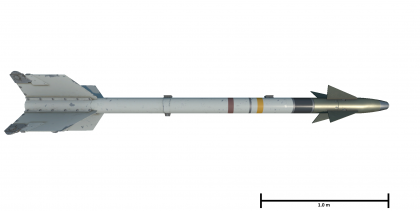AIM-9H Sidewinder
| This page is about the American air-to-air missile AIM-9H Sidewinder. For other versions, see AIM-9 Sidewinder (Family). |
Contents
Description
The AIM-9H Sidewinder is an American infrared homing air-to-air missile, it was introduced in Update "Danger Zone".
Vehicles equipped with this weapon
General info
The AIM-9H is a further development of the AIM-9G, retaining all of the AIM-9Gs characteristics with a better tracking rate.
| Missile characteristics | |
|---|---|
| Mass | 88 kg |
| Guidance | IR |
| Aspect | Rear-aspect |
| Lock range | 5.50 km |
| Launch range | 18 km |
| Maximum speed | 2.5 M |
| Maximum overload | 18 G |
| Missile guidance time | 60 secs |
| Explosive mass | 3.53 kg TNTeq |
Effective damage
The AIM-9H, like all of its competitors, uses a High Explosive warhead to shower the target in shrapnel.
Similarly to nearly every missile in the game, a direct hit from the missile will most likely destroy the target aircraft either through the explosion itself or the resulting damage and/or fire.
Comparison with analogues
The most similar thing to the AIM-9H is the AIM-9G, borrowing the same degrees of boresight and rocket motor, but the AIM-9H features a better track rate.
Usage in battles
The AIM-9H is most effective against unaware or occupied enemy aircraft from about 2.4 kilometers or less (1.5 miles) from the rear or side aspects, able to tackle many opponents who are even attempting to evade the missile.
Depending on the encountered aircraft, the AIM-9H can occasionally lock an enemy aircraft from head-on, allowing a skilled player to launch said missile from the front.
Most players will be expecting an AIM-7 from your aircraft, so an AIM-9 would sufficiently confuse the enemy and net you a good hit.
Using the AIM-9H is situational however, as a misjudged shot could either result in a miss, or worse, a friendly fire incident. Good judgement and timing will net you many rewards, but the IR seeker is unlikely to differentiate between friend or foe when it matters most.
Pros and cons
Pros:
- Long lasting rocket motor allowing for shots beyond 3 km
- Large seeker ring making off boresight shots more effective
- No G limit when launching the missile so you can launch the missile when turning at an high angle of attack
- Front-aspect locks are occasionally possible
Cons:
- Small explosive warhead
- IR Seeker sometimes tracks friendlies
History
The AIM-9G variant of the Sidewinder was thought by some engineers at China Lake to be the pinnacle of Sidewinder designs. Compared to the preceding AIM-9D, the AIM-9G introduced the "Sidewinder Expanded Acquisition Mode" (SEAM) that allowed the Sidewinder to be slaved to the aircraft's radar or perform a circular scan of around 25 degrees. Though some engineers thought the AIM-9G was perfect, others engineers involved with the Sidewinder project since its inception like William McLean (originator of the Sidewinder weapon) and Walter LaBerge (Sidewinder's missile engineer) believed that the AIM-9G's reliability could be further enhanced.[1]
In December 1965, McLean and LaBerge (who is at the time employed by Philco-Ford) got together to consider options of improving the missile's reliability. One proposal was to convert all remaining missile electronic components to solid-state gradually. While the US Air Force was open to this gradual replacement of electronics into solid-state, the proposal to the US Navy by engineer Walt Freitag was instead a complete the transition to solid-state all at once.[1] The tracking rate was improved from 12 degrees/second into 20 degrees/second to complement the missile's more powerful actuators. The new missile, designated the AIM-9H, was introduced into the US navy service in 1972 at the tail end of the Vietnam War, though sources are mixed on whether they were used in combat before the US withdrawal in 1973. A total of 7,700 AIM-9H units would be produced between 1972-1974 by Philco-Ford and Raytheon.[2]
Projects after the Vietnam War to continue improving the AIM-9s led to using the AIM-9H as the basis of the improvements. China Lake started the program as the AIM-9H Product Improvement Package (PIP). The United States Air Force, also seeking a missile improvement from their AIM-9E and AIM-9J models of the Sidewinder, became involved with the US Navy's AIM-9H PIP under direction the Pentagon. The variety of improvements inputted by both service branches led to the missile that would be designated as the AIM-9L.[3]
Media
Excellent additions to the article would be video guides, screenshots from the game, and photos.
See also
- Related development
External links
- Citations
- Bibliography
- Parsch, Andreas. 2008. "AIM-9." Directory of U.S. Military Rockets and Missiles. Last modified July 09, 2008. Website (Archive)
- Westrum, Ron. 2013. Sidewinder; Creative Missile Development at China Lake. Annapolis, MD: Naval Institute Press.




